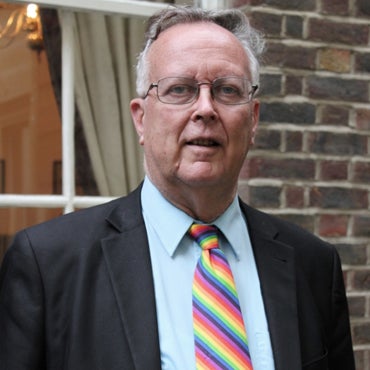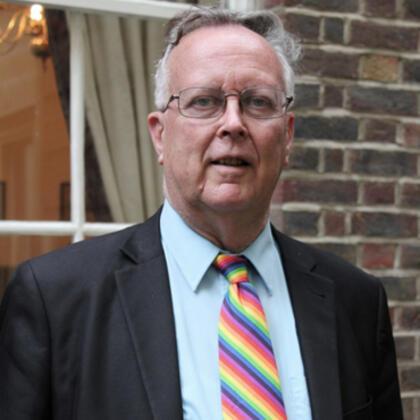YEA, WHY TRY HER RAW WET HAT?
Share
- Details
- Transcript
- Audio
- Downloads
- Extra Reading
It is often said that mathematics and music go together, but what does this mean? This illustrated lecture features a small choir and instrumentalists who perform music ranging from Tallis and Bach to Bartok and Hindermith, and answers such questions as: why are pianos always out of tune? Can music have a 'geometry'? Why are there seven colours in the rainbow? and What is the meaning of the title of this talk?
Download Transcript
YEA, WHY TRY HER RAW WET HAT?
Robin Wilson (Open University)
It has often been said that mathematics and music go together, but where’s the mathematics in this?
[Keyboard – first line of Haydn’s Minuet al rovescio]
or in this?
[Keyboard and recorder – bars 7-10 of Purcell’s Chaconne]
or even in this?
[Choir – last ‘ Trinidad ’ of the Geographical fugue]
In this lecture, I’d like to share with you some aspects of music that have connections with mathematics. This is an enormous topic, and I’ll have to leave out several important areas. Instead, I’ll concentrate on a few topics that interest me – and there’ll be lots of music for you to listen to and to join in with.
Let’s start with rhythm – possibly the most fundamental feature of music, and one which is, by its very nature, mathematical. From earliest times people have derived pleasure from the noises obtained by beating flat surfaces with sticks or clapping one’s hands, and a number of composers have incorporated such pitchless rhythms into their music. Here’s a short extract from a piece based on African gahu rhythms from Ghana by the American composer Carlton Gamer:
[CD – extract from Gahu on J, K, R]
The 20th-century American composer Steve Reich developed this idea in his mathematically-based ‘clapping games’. Here’s one of his simplest, with two competing rhythms. We’ll ask our choir to illustrate them.
Rhythm 1 is as follows:
[Choir illustrates rhythm 1]
and here’s rhythm 2:
[Choir illustrates rhythm 2]
If we now put them together, we get a pleasant cross-rhythm emerging. To illustrate this, I’ll need your help. If your age is an even number, try the first one:
[Choir and half of audience does rhythm 1]
If your age is an odd number, do the second one:
[Choir and other half of audience does rhythm 2]
And now let’s put them together:
[Choir and audience combines them]
And here’s a wonderful rhythmic piece for speaking chorus by Ernst Toch. It’s called Geographical fugue, and it’s based on lots of place names – Trinidad, and the big Mississippi, and the town Honolulu, etc.:
[Choir – Geographical fugue]
Moving on to musical pitch, the connections with mathematics have been recognized for at least 2500 years. The story (probably untrue) goes that the Greek mathematician Pythagoras was passing a blacksmith’s forge when he heard the hammers giving off harmonious sounds as they beat out iron on the anvil. We are fortunate that Pythagoras is here today to tell us what happened:
[Pythagoras reads anvil story] Those hammers which gave the consonance of an octave were found to weigh in the ratio 2 to 1. He took that one which was double the other and found that its weight was four-thirds the weight of a hammer with which it gave the consonance of a fourth. Again he found that this same hammer was three-halves the weight of a hammer with which it gave the consonance of a fifth.
Indeed, to the Pythagoreans, ‘everything was number’. They desired to assign simple whole numbers to everything – and in particular they assigned ratios of numbers to musical intervals. For example, as Pythagoras noted, a ratio of 2 to 1 corresponds to an interval of an octave, such as low C to high C:
[Keyboard plays C, then C', then both together]
Similarly, a ratio of 3 to 2 corresponds to a perfect fifth, such as C to G:
[Keyboard plays C, then G, then both together]
and a ratio of 4 to 3 corresponds to a perfect fourth, such as low C to F, or G to high C:
[Keyboard plays G, then C', then both]
The Greeks regarded such ratios as providing a key to the structure of the whole universe, as they were supposed to relate to the ratios of distances between the planets.
How do we combine intervals? We simply multiply the ratios. So to combine a fifth (that’s 3 to 2) and a fourth (that’s 4 to 3), we multiply these ratios, giving 4 to 2, which is the same as 2 to 1, an octave.
[Keyboard plays C to G, then G to C', followed by C to C']
The Greeks were also familiar with the harmonic series, the notes we get by taking a vibrating string and dividing it into 1, 2, 3 or more parts. These harmonics are also the notes we get from a valveless horn, such as a hunting horn or a garden hose, by increasing our breath pressure. Here are the first few notes: they get increasingly out of tune the further along the sequence we go.
[Keyboard plays harmonic series: bottom C – low C – low G – middle C – E – G – Bb – C' – D' – E' – F']
Several composers have used this idea in their compositions. Here’s the Prologue from Benjamin Britten’s Serenade for tenor, horn and strings, played without valves, and giving quite an eerie sound. I’ve marked the notes of the harmonic scale on the music: those with circles around them are at best approximations to the notes written.
[CD – Prologue from Britten’s Serenade]
These harmonics are why two different intervals playing the same note can sound quite different. Each note is a mixture of these harmonics: a pure tone is represented by a sine wave, and we get different tone qualities by adding to this sine wave a succession of harmonics that differ for the different instruments.
However, the Pythagorean intervals can cause us trouble. Let’s do a little arithmetic, and spot intervals from their position in the harmonic series. For example, the ratio of 12 to 6 is the same as the ratio of 2 to 1, so we get an octave, G to G' [keyboard];
the ratio of 15 to 10 is the same as 3 to 2, so we get a fifth, E' to B' [keyboard];
and the ratio of 12 to 9 is the same as 4 to 3, so we get a fourth, D' to G' [keyboard].
But what about the interval from D' to A'? That’s a fifth [keyboard], but its ratio is 13 to 9, which is smaller than 3 to 2. We’re in trouble! And we get into even more trouble if we try to compare 7 octaves with 12 fifths. Here are some octaves:
[Keyboard plays several octaves, starting from low C]
and here are some fifths:
[Keyboard plays several fifths: low C – G – D – A – E – B – (F#/Gb), etc.]
Let’s compare the ratios. For 7 octaves we find the overall ratio by multiplying 2 seven times, which is 128. But for 12 fifths we need to multiply 3/2 by itself twelve times, and that’s over 129. So they’re not the same, even though they agree on a piano. Later we’ll see how to get out of this difficulty, but it will be through a compromise. Basically, the Pythagorean system is flawed.
In spite of these problems, the Pythagorean approach to music came to play a prominent role in study and education. Plato, in his Republic, listed the subjects he considered to be a necessary part of the education of the ideal ruler: the four mathematical arts of arithmetic, geometry, astronomy, and music studied in the Pythagorean way. These mathematical arts, later called the quadrivium, combined with the three areas of the trivium (grammar, rhetoric and logic) to comprise the seven liberal arts, the corner-stone of learning from Greek times onwards, through the medieval period in Europe (Italy, Paris, Oxford, and so on), until around the 17th century. If you’d been at university in the Middle Ages, you’d have studied these subjects too.
Let’s now have some more music. By the 11th century, music was still based largely on octaves, fourths and fifths, and pieces using parallel fourths and fifths were common in churches and monasteries. To see how ‘churchy’ fifths in parallel can sound, let’s take the National Anthem and sing it in parallel fifths. Here’s the tune, starting on A.
[Keyboard plays first half of ‘God save the Queen’, starting on A]
If your age is an even number, sing this now, to ‘la’.
[Half of audience sings first half, starting on A]
If your age is an odd number, sing it through to ‘la’, but starting on a low D.
[Other half of audience sings first half, starting on low D]
Now let’s put the two together, and sing the whole song in parallel fifths.
[Audience sings all of tune in parallel fifths]
As you can hear, it’s quite an interesting effect.
As the years went on, there was increasing use of other intervals, such as the major third with ratio 5 to 4 [keyboard – C, then E, then both],
the major sixth with ratio 5 to 3,
[keyboard – C, then A, then both]
and the minor third with ratio 6 to 5
[keyboard – E, then G,then both]
These numbers are larger than the 1s, 2s, 3s and 4s we had earlier.
But with these extra intervals, our earlier difficulties become even more horrendous than before. For example, to go up from C to D we can go up a fifth to G and then down a fourth, giving a ratio of 3/2 divided by 4/3, which is 9/8. Or we could go up a fourth to F and then down a minor third, giving a ratio of 4/3 divided by 6/5, which is 10/9. Surely 9/8 and 10/9 can’t both be correct.
Several people tried to smooth over these difficulties, such as the early seventeenth-century Minimite friar Marin Mersenne, a mathematician who wrote extensively about music (here’s his Harmonie universelle), and the German astronomer Johannes Kepler, who returned to the Greek idea of musical intervals between the various planets – the harmony of the spheres – each planet had its own scale.
And even Isaac Newton got in on the act. He was not musical – he once heard Handel play on the harpsichord, and all he could think of to comment on was the elasticity of Handel’s fingers. Newton spent much time on musical scales, and even tried to link the seven notes of the musical scale with the colours of the spectrum. That’s why we often say that there are seven colours in the rainbow – it arises from Newton’s combined researches into optics and music.
To get around these problems, a number of different scales were proposed, and eventually the idea of equal temperament emerged. In an equally tempered scale we give each of the twelve semitones in an octave the same ratio – it’s the twelfth root of 2 (which is about 1.059 to 1). So the frequencies of the twelve semitones form a geometrical progression – a form of exponential growth.
Equal temperament turns out to solve most of our problems, except that now every interval other than the octave is slightly out of tune. Here’s a table comparing the ratios for equal temperament with the Pythagorean ratios. The fifth is pretty accurate – 1.498 compared with 3/2, or 1.5 – and so is the fourth – 1.335 compared with 4/3, or 1.333. But the major third is about 1.26, which compared with 5/4, or 1.25, is rather sharp. Soany keyboard tuned to equal temperament (as they usually are) must necessarily be slightly out of tune!
Of course, if we use equal temperament, then there’s no reason why we should stick to scales with twelve semitones, especially since we can now produce notes electronically as accurately as we wish. So why not use scales with 7 notes (for example), or with 31 or 53?
In fact, such scales have already been used – in many countries and over many centuries: 7-note scales are used by the gamelan orchestras of Indonesia, and scales based on 53 notes have been used in China.
31-note scales are particularly interesting, as they give us very accurate fifths, fourths and thirds. Here’s a baroque keyboard with 31 notes to the octave. Such keyboards were actually built – in fact, Handel may have played on one – and composers have even composed in the 31-note equal-tempered scale. Here’s one such piece, Organum, composed by Carlton Gamer and based on words by Ezra Pound; the vocal line was electronically synthesized from the composer’s voice.
[CD – Organum]
For the rest of this talk, I’d like to describe various mathematical devices that composers have used in their music.
One of these mathematical devices is a canon or round, where the main theme is passed from voice to voice – in mathematical terms, this is known as translation. Many canons will be familiar to you – London ’s burning, Frère Jacques and Row, row, row the boat.
In one of the most famous canons, the 16th-century Tallis’s Canon, the tenors sing exactly the same notes as the sopranos, but four beats later. Here’s the basic tune [sopranos – first two lines to ‘la’]
and here’s the whole thing:
[Choir – Tallis’s canon, two verses – sopranos and tenors to ‘la’; altos and basses hum]
One of the most remarkable canons ever written dates from before 1300 – Sumer is icumen in. Here the two lowest parts are in canon, while the four high parts do their own canon above. Here are the lowest parts, sung in canon by the tenors and basses:
[Choir – Sumer is icumen in, two lowest parts three times (bass starting first)]
and here are the four high parts, sung in canon by the sopranos:
[Choir – Sumer is icumen in, four highest parts]
and here’s the result when we put them all together:
[Choir – Sumer is icumen in, full version]
From the earliest times, composers seemed to enjoy setting themselves challenges, seeing whether they could compose acceptable music subject to given mathematical restrictions. For example, in this unusual Tudor canon, three of the parts start in close canon – these three are the same, and start in quick succession – while the other part, known as acantusfirmus, sings a 4-note phrase over and over again – but first with 8 beats on each note, then 7 beats on each note, then 6 and 5, and so on, right down to 1 and finally to 1/2.
Another challenge is to compose music in which the parts are in canon, but are sung at different speeds. Here’s one by Josquin dès Pres from the fifteenth century – the Agnus Dei from his Missa l’Homme Armé. Here’s the bass line:
[Choir – Josquin’s Agnus Dei, basses only, first four bars]
This identical tune is also sung by the tenors, but at half speed starting on a different note, and by the sopranos in triple time. The final effect is complex and very striking:
[Choir – Josquin’s Agnus Dei, sung in full]
An even more complicated example was constructed by the American composer Conlon Nancarrow. In one of his canons, four voices play the same theme at speeds in the ratios 17: 18: 19: 20, all entering at different times in such a way that most of the piece seems completely chaotic – but at the climax of the work they all come suddenly and miraculously into time with each other. Apparently, at one performance there were complaints from the lecture room next door, where they were trying to hold a seminar on ‘Coping with stress’!
One of the most beautiful canons I know is the Chaconne from Henry Purcell’s masque Dioclesian. Here, two recorder players are in exact canon throughout, the second just two bars after the first, while underneath is a ground bass – a 6-bar phrase repeated over and over again throughout the piece. Here’s the ground bass [keyboard]; and we’ll now play the whole chaconne. Try to listen to both the ground bass and the canon.
[Purcell’s Chaconne – keyboard and recorders]
Many mathematical devices used in music involve the geometrical idea ofsymmetry – an important area of mathematics that is studied under the name of group theory. One example is the palindrome or crab canon – a piece of music that is the same whether played forwards or backwards: it exhibits the same symmetry as we see in the letters A and M. Here’s a crab canon from Bach’s Musical offering – reading the first line backwards gives the second line, and vice versa.
The earliest crab canon I know is by Guillaume de Machaut in the 14th century, who used this device in setting the words ‘My end is my beginning’ – and a recent example is by the American composer George Crumb, whose madrigal ‘Why was I surrounded by mirrors’ is full of patterns that run the same way backwards as forwards, such as this one.
[CD – George Crumb]
Such palindromes were also used by Alban Berg in his opera Wozzeck, where whole chunks of music are the same backwards as forwards, and there’s even a whole opera, Hin und zurück by Paul Hindemith, which you can listen to either backwards or forwards.
One of my favourite examples is this delightful minuet by Joseph Haydn from his Piano Sonata No. 41, which the composer liked so much that he used it again in his 47th Symphony.
[Keyboard – Haydn’s Piano sonata No. 41 – minuet only, with repeats]
My least favourite example is also by Haydn – his Canon cancrizans, where each section is a three-part round on the words, Thy voice, O Harmony, is divine. Here each part in Section 2 is the same as one of the parts in Section 1 backwards, and the same thing happens also when the music is turned upside down! So here the symmetry is that of the letter H or X. By imposing so many restrictions, the composer managed to produce a piece with no musical merit whatsoever, so we won’t be performing it. He wrote it on receiving an honorary degree from Oxford University in 1791, and it’s very fortunate that it wasn’t performed untilafter he’d received his degree!
The device of turning music upside down has been used effectively by some composers, exhibiting the symmetry of the letters C, E and K. For example, the Hungarian composer Béla Bartók used it in hisMikrokosmos, in a piece called Subject and reflection; here’s a short bit of it.
[Keyboard – Bartok’s Mikrokosmos]
There’s also an ingenious example by Bach of two fugues, each of which is the inversion of the other. Here’s the beginning of the first one:
[Keyboard – Bach fugue 1]
and playing it upside down gives the beginning of the second one:
[Keyboard – Bach fugue 2]
Incidentally, several of Bach’s compositions are full of mathematical symmetries, such as the ones you’ve just seen.
And here’s another interesting type of symmetry. In Paul Hindemith’s piano work Ludus Tonalis, the whole of the last section is obtained by taking the first section and playing it upside down and backwards: it starts here... and after a whole hour we get this. So, ignoring the last chord, if we rotate the whole movement through 180 degrees, we don’t change it at all – the symmetry is that of the letters N, S and Z.
[Keyboard – Ludus tonalis]
These types of symmetry all appear in pieces of so-called twelve-tonemusic, where we first list the twelve notes in the octave in any order we choose (this is called a tone row) –
[keyboard – play the tone row]
and then we can play them transposed up any number of semitones – or inverted – or both – and any of these can also be played backwards. Here’s an example, from Schoenberg’s PianoSuite, showing six forms of the tone row – the twelve notes can appear in any octave.
Many recent composers have employed mathematical ideas in their compositions. For example, Debussy and Bartók apparently designed the proportions of several of their pieces in accordance with golden section, while Alban Berg based the structure of his Lyric suite on the two numbers 10 and 23. The American composer John Cage used ideas of probability, tossing a coin to determine the various musical parameters, and in hisMetastasis Iannis Xenakis based his glissandos on the lines of a curved geometrical surface – actually, the Philips Pavilion at the 1958 Brussels World Fair.
The Oxford composer Robert Sherlaw Johnson used fractal ideas to weave sound patterns. Using this particular type of recurrence relation, for different chosen values of a, b and c, he obtained attractive patterns of points (x, y) in the plane, such as these ones. Next, taking each x-value to represent pitch and each y-value to represent loudness, he obtained sound patterns which he then used as the basis of his compositions.
Sir Peter Maxwell Davies, Master of the Queen’s Music, has used magic squares in several of his compositions. In one piece, he started with this 8-note piece of plainchant, and this 8 × 8 magic square in which each row and column adds up to the same sum, 260. Combining these in a particular way, he obtained his so-called Magic squareof Mercury, and then by tracing through the numbers in it in various ways he was able to generate the pitch material for the composition.
Finally, I’d like to show you how Carlton Gamer was so inspired by some geometry that he based one of his compositions on it. In mathematics, there’s a geometrical object known as the seven-point projectiveplane, orFano plane. Don’t worry about what it is – just notice that it has seven points, which I’ve called A, E, H, R, T, W and Y, and seven lines, each linking three points – I’ve had to bend one of the lines to fit it in, but that’s OK. In fact, if you look at the three letters on each line, you can spell out the title of this talk – YEA, WHY TRY HER RAW WET HAT?
What Carlton Gamer did in his composition Fanovar was to assign a musical instrument to each of the seven points of the diagram, and then to use the lines to group the instruments into trios that play together at various points in the work. For example, the beginning of the second variation starts with the trio of flute, clarinet and violin, which is this line. He then took another seven-point diagram, which he found in a book on graph theory that I co-authored, and used paths in this diagram to generate the melody lines – for example, the Cs, Ds and Gs here are obtained by tracing around this triangle, and a musical phrase of A, B, F# and E is obtained from this path here.
Needless to say, it’s all much more developed than this, but I’ve no time to go into all the complexities here. Instead, let’s listen to the beginning of this mathematical piece of music.
[CD – extract from Fanovar]
Finally, I’d like to express my thanks on your behalf to all the performers for their help – and to thank you all for joining in so well.
© Professor Robin Wilson, Gresham College, 2 May 2006
This event was on Tue, 02 May 2006
Support Gresham
Gresham College has offered an outstanding education to the public free of charge for over 400 years. Today, Gresham plays an important role in fostering a love of learning and a greater understanding of ourselves and the world around us. Your donation will help to widen our reach and to broaden our audience, allowing more people to benefit from a high-quality education from some of the brightest minds.


 Login
Login






